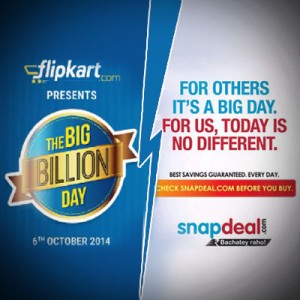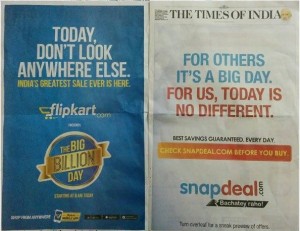According to an old prophecy, you wouldn’t have to go looking for things and everything would be delivered to you. E-commerce has been one of the biggest boons of the 21st century to have fulfilled the prophecy and make the lives of millions less cumbersome with doorstep deliveries.
Online presence in India was just 21 million in 2004, which rose significantly to 243 million in 2014. Bazee.com was the first Indian auction based portal which was later acquired in 2004 by eBay. Travel and airline websites like Makemytrip, Yatra and Cleartrip were making inroads during this time but were not quite yet there. The market was wide open. Today, still the big market share of e-commerce is being dominated by travel websites with an estimate of 70 per cent covered by them. This does not mean that e-tailers are doing badly; the online retail and the market place websites have grown from 10 per cent in 2009 to 18 per cent in 2013.

This number is however a drop in the ocean when compared to brick and mortar retail. The online retail space is only 1 per cent of the total retail market in India. But there is a rapid growth and the market trends are quickly changing. Internet enabled smartphone penetration is the biggest reason for the rise and has given people the power to reach to these stores from all over India.
The e-commerce industry offers great benefits to the Indian economy, the customers and the society at large, especially to small businesses, small merchants, semi-urban and rural population. It is estimated that the e-commerce industry is expected to contribute around 4 per cent to the GDP by 2020.
Flash Sales
Concepts such as flash sales, ‘by invite only’ sales, ‘Cyber Monday’, ‘Black Friday’ or the ‘Great Online Shopping Festival’ have been smashing hits in the past in West and such innovations will continue to play an important role to promote online shopping. These tactics, in addition to the existing sales, coupons and deals are welcome by the Indian customer. ‘The Big Billion Day Sale’ and ‘Savings Day’ are examples of how flash sales can be a big hit and a disaster, both at the same time.
Flipkart, which was born out of flat no 610, inspired the founders to celebrate 6 October (6/10) with their users and came up with the idea of ‘Big Billion Day Sale’. This was something Flipkart was hoping to cash in on the Indian festive season and having already experienced the success of Mi flash sales, were hoping to put almost all the products under heavy discounts.
This sale was aimed at increasing the popularity and achieving 1 billion sales in a day. All this was achieved but in the process, the website’s reputation went for a toss. The customers weren’t able to buy the products, the servers were jammed and orders were cancelled automatically. The buyers were disappointed and angry reactions led to social media outrage.
Although, the company claimed to have sold 10 items every second and sold products worth of Rs 650 crore, the errors and the slow service led to frustration among the customers. There had been such an outcry that the founders Sachin and Binny Bansal had to apologise to their customers via email for not meeting customer expectations.
 Snapdeal too cashed in on the Big Billion Day Sale and announced similar sale and advertisements on the front page of leading dailies; forcing Flipkart to settle for the second page in them. It also announced a similar flash sale titled ‘Snapdeal Savings Day’ where it claimed to have sold products worth Rs 600 crore.
Snapdeal too cashed in on the Big Billion Day Sale and announced similar sale and advertisements on the front page of leading dailies; forcing Flipkart to settle for the second page in them. It also announced a similar flash sale titled ‘Snapdeal Savings Day’ where it claimed to have sold products worth Rs 600 crore.
Amazon too had resorted to discounts and sales to attract customers but not on such a scale where the website was swarmed with technical glitches.
E-commerce industry is one of the rising industries in India currently and the restrictions on foreign direct investment (FDI) in inventory based consumer e-commerce (B2C) have led to a severe capital constraint which has put a question mark on the survival of many e-commerce players. E-commerce is a capital demanding business and with severe problems in technology infrastructure, low profit margins and poor physical infrastructure (logistics and distribution), this industry needs regulations that are supportive and that provide for an environment conducive to growth. With government allowing FDI in B2B for the e-commerce websites, most of the e-tailers have been using this model for their websites.
The growing industry will also have a positive spillover effect on associated industries such as logistics, online advertising, media and IT/ ITeS. Currently e-commerce accounts for 15-20 per cent of the total revenues for some of the big logistics companies. E-commerce companies also rely on costlier payment methods such as COD (Cash on Delivery), (access, logistics, payments are part of infrastructure).
One of the many reasons for the e-commerce industry to really grow is – logistics. Logistics in developing economies such as India may act as the biggest barrier to the growth of the e-commerce industry. Till date, logistics models developed in India target the metropolitan and the tier-1 cities where there is a mix of affluent and middle classes and the internet penetration is adequate. Flipkart has set up several regional warehouses and is constantly increasing the supplier base across the country to achieve low transportation cost by ensuring delivery from the nearest supplier or regional warehouse. It is also growing its logistics arm E-Kart whereas Amazon India is building capacities with its logistic arm Amazon Logistics.
Advertisement
 Advertisements have been a great enabler for e-commerce sites’ success story. The early TV spots with kids acting as adults to buy products from Flipkart were a brilliant campaign that captured the audience’s frenzy. But back then the war was not so fierce and the competition not so tough.
Advertisements have been a great enabler for e-commerce sites’ success story. The early TV spots with kids acting as adults to buy products from Flipkart were a brilliant campaign that captured the audience’s frenzy. But back then the war was not so fierce and the competition not so tough.
Now with equal contest from Snapdeal and Amazon, Flipkart is putting in a lot more resources to market the website and have the visibility all over print and media. To understand how big advertising has become for these e-tailers, you have to understand that in 2013 (according to a few reports), the e-commerce websites contributed to 4 per cent of the revenues to the ad agencies, which has significantly shot up to 12 per cent this year. This year alone Flipkart has spent close to Rs 100 crore on advertisement, and now is valued at over Rs 69,000 crore overall.
Similarly, Snapdeal and Amazon have turned their attention to market their websites regularly on different platforms to make the audience aware of their presence and the ease of shopping from one’s couch. Each has invested close to $80-100 million on advertisements this year to grab eyeballs.
Acquisitions
Myntra, another e-commerce website that focuses on apparels and casual lifestyle products, was acquired by Flipkart in 2014 for almost Rs 2,000 crore.
Amazon to counter Flipkart’s move is in talks to buy-out Jabong. The sale could be upwards of $1 billion and could be the deciding factor for the Jeff Bezos run company to understand how they fare in the country. The fashion retail on the internet is one of the most popular segments and the margins are even higher than electronics or books. Flipkart and Myntra combined, enjoy 50 per cent of the market share with Jabong coming in at second at 25 per cent.
Also making news this year was Snapdeal being eyed by Alibaba – which also had backing from Softbank Corp. This could be a big move for both Alibaba and Snapdeal. Alibaba will get a big foothold in the country even after entering the market after its biggest rival – Amazon and Snapdeal will have a huge cashflow to compete with the likes of Flipkart and Amazon and have a say in where the e-commerce industry is headed in the country.
Exclusive Tie-Ups
Exclusive tie-ups with companies like Motorola and Xiaomi have made Flipkart the only website to sell these phones in India and the only way to buy these phones was to login to Flipkart. This gave Flipkart an added advantage over their competitors and added to their sales and user base enormously.
Motorola has an exclusive tie-up with Flipkart to sell its phones on the web portal. The initial sale of Moto E, Moto G and Moto X were phenomenal. The phones were selling like hot cakes. The new gen phones from Moto too found their home in Flipkart.
The Xiaomi partnership was one of the biggest boosts to the website in terms of traffic and sales. The idea of flash sales took consumers by storm. The Mi phones Mi3 and Redmi 1s went missing from the shelves the seconds they went on sale. Till date Xiaomi has sold close to 3 lakh phones on Flipkart and is now the 3rd largest phone vendor in the world.
Amazon recently announced an exclusive tie-up with the Chinese phonemaker, Oneplus to sell its Flagship killer Oneplus One. Also, the partnership with Microsoft to sell its new gen console Xbox One on the website has helped the American company to get a strong foothold in the country.
Conclusion
The e-commerce market is now a three way tussle with Snapdeal managing to get Softbank to invest $627 million and also Jack Ma’s Alibaba showing interest in the company, Amazon having its own resources and Flipkart beginning to get a lot of attention from investors from all over the world. This will only renew the fact that the population in the country is an advantage for these e-commerce sites where the mobile phone market is set to rise with over 340 million phones set to be sold within next 3 years. Also, what has helped these e-tailers is the fact that a lot of this population is young and urban or semi-urban, who want to live with some luxury and emulate that on the things they use.
Generating revenues is the big factor for these website and innovations like Big Billion Day Sale will make an impact on how Indians shop in the coming years.
